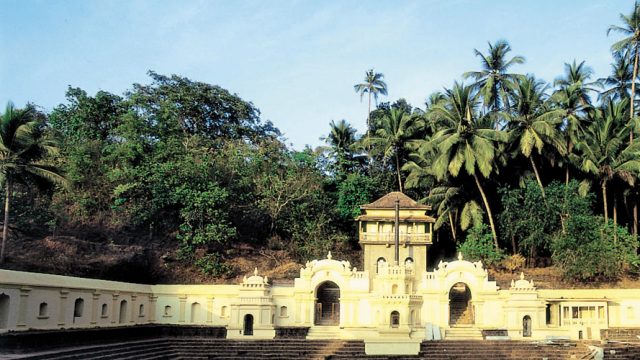The majority of Goa’s temples are located in the New Conquest areas, which came into Portuguese possession a good 270 years after the European power acquired its first foothold in Goa in 1510 (these places are hence called New Conquest areas). Before that, the most impressive temples were located in the fertile Old Conquest areas which now form the coastal talukas of Tiswad, Salcete and Bardez.
The Portuguese had come to India seeking “Christians and spices”, and they set about acquiring the former with some zeal. Initially, the Europeans used persuasive methods — gifts, discharging debts, emancipating slaves and those who were considered untouchables, and “seducing women”, among them — as a way to showing Goans the true path. When this didn’t work, they employed other means: physical violence, forcibly converting orphans, expelling Hindus from conquered lands and confiscating their properties, and destroying temples.

Hindus fled to the outlying territories that the Portuguese would acquire only when their enthusiasm for proselytising had flagged. Tales abound of temple idols being spirited away in the dead of night, mainly to the safety of Bicholim and Ponda, where the Shantadurga Temple also found refuge. Its original home in Marmugao Taluka was burnt by the Portuguese in 1567.
Instead of causing the community to draw inwards, the period of persecution saw the flowering of a temple style that drew both from the Islamic buildings of Bijapur (a kingdom of which Goa had once been a part) and from Goa’s Christian structures.

“Goa’s New Conquest temples are different from most Hindu structures elsewhere in India by their emulation of Western spatial divisions and their use of a European architectural vocabulary,” writes David Martin Kowal, a professor of art history at the College of Charleston, South Carolina. Because the Portuguese forbid Hindus from conducting religious ceremonies at home, the temples had to be large enough to allow for all manner of rituals and celebrations.
Many of the state’s temple complexes have similar features. The walled enclosure is entered through an impressive gate above which is a naubatkhana (naubat is a performance by two shehnai players, with a third playing the tabla; naubatkhana is a place where a naubat performance is given), in which musicians sit. The shrine of the main deity is usually in the centre of the temple courtyard.

Tirtha, or a stepped tank, is often found on the grounds, as are dharamshalas or rest houses for pilgrims. A pedestal for the sacred tulsi plant often finds place in the courtyard (according to legend, the tulsi was a mistress of Vishnu, turned into a plant by Lakshmi, his jealous consort). Shrines to the parviara devatas frequently surround the main temple. A shed on one side houses the ceremonial rath, on which the temple deity is paraded during festivals. The multi-tiered lamp, towering in front of the shrine, is a distinguishing feature of Goan temples. While Maratha temples also had tapering columns with brackets to hold the lamps, the Goan variant resembles a belfry, with niches for the lamps.
The garbha griha, or sanctums, of Hindu temples in many other parts of India are topped by shikharas, sanctuary towers that symbolise the heavenly mountain from which the Ganga flows to Earth. But in Goa, the shikharas, most often, are replaced by rather ornate domes.

The inspiration drawn from church architecture is also visible from the tripartite division of the mandapa (hall). “It is not unusual to find the sanctuary chamber of Goan temples squared while the entrance porch is often configured with a central nave and flanking side aisles,” Kowal notes. The mandapa roofs often have terracotta tiles and eaves, lending them a certain Iberian exuberance that’s difficult to miss.
Inside the temples, the wooden pillars often bear traces of Islamic architectural patterns, especially in the shape and proportion of their arches. Musical instruments are stored in an outer hall, as is the palki for the deity’s weekly promenade.
Many temples have intricate panels of wood carvings that recount mythological tales. Glazed tiles from Macau — and banks of chandeliers also point to a flair for accepting the wonders of distant lands. In many temples, the door to the garbha griha has an elaborate silver frame, embossed with designs that gather together motifs from Islamic, Christian and Hindu art.
The Sé Cathedral and the Church of Nossa Senhora da Divina Providencia in Old Goa are thought to have had a profound influence on Goan temple builders. “From the former, they appear to have learnt the Neo- Roman idiom in its Mannerist mode,” suggests José Pereira, professor emeritus of theology at New York’s Fordham University. “From the latter, itself modelled on Michelangelo’s St Peter’s in Rome, they adopted the dome… But they never designed its drum as a cylinder, like that of the Providencia, but always as an octagon (a type common in Spanish Neo-Roman churches).”




